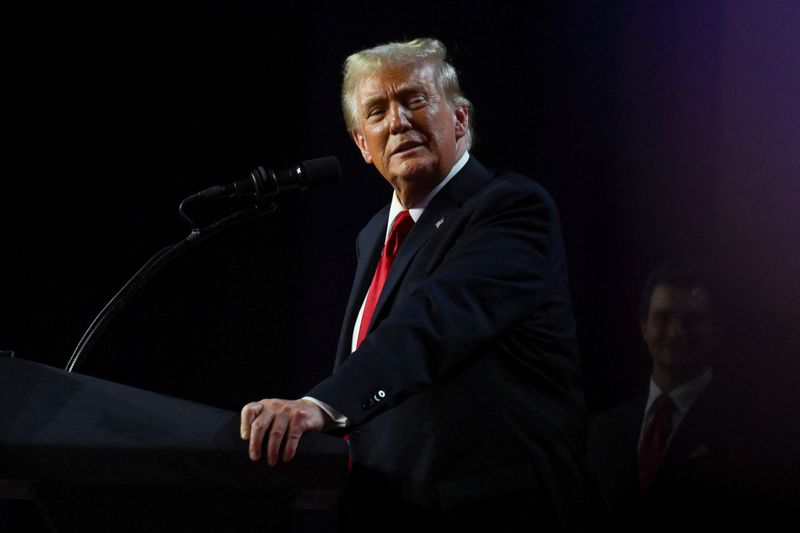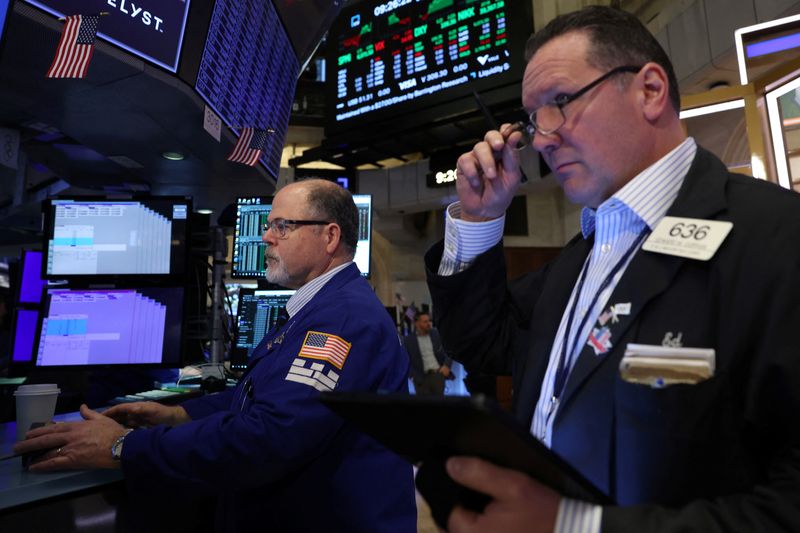Select Language

By Casey Hall
SHANGHAI (Reuters) - More than half of the American businesses in China, the highest level in five years, say they are concerned about a further deterioration in the bilateral relationship between the world's two largest economies, a survey published on Thursday shows.
The annual survey by the American Chamber of Commerce (AmCham) in China showed 51% of respondents were concerned about a future deterioration in the U.S.-China relationship.
It was released just days after U.S. President Donald Trump took office for a second term with the threat of increasing trade tariffs on Chinese imports.
"A stable and constructive relationship, grounded in economic and trade ties, is critical not only for the prosperity of our two nations but also for global economic stability," said AmCham China Chair Alvin Liu.
Geopolitical tensions, policy uncertainties, and trade disputes were major concerns of U.S. businesses in China, AmCham China said.
The survey of 368 AmCham China member companies was completed between October and November last year, partly after Trump won the presidential election on Nov. 5.
His previous term as president was marked by a U.S.-China trade war and general decline in diplomatic goodwill between the two countries that did not markedly improve during President Joe Biden's tenure.
On Tuesday, Trump said his administration was discussing a 10% punitive duty on Chinese imports that could be imposed from Feb. 1 in relation to China's part in the global supply chain of fentanyl.
Almost half of the respondents still rank China as a top-three global investment priority, around the same level as last year. However, the proportion of companies that no longer list China as a preferred investment destination has more than doubled to 21% compared with pre-pandemic levels and rose three percentage points from last year's survey.
Also around the same level as last year are the proportion of firms reporting unfair treatment in China compared with local firms - around a third of businesses - particularly in relation to market access and public procurement.

(Reuters) -Saudi Arabian Crown Prince Mohammed bin Salman told President Donald Trump that the kingdom wants to put $600 billion into expanded investment and trade with the United States over the next four years, the Saudi State news agency said early on Thursday.
In a phone call between the two leaders, the crown prince said the Trump administration's expected reforms could create "unprecedented economic prosperity", the state news agency reported.
The report said Saudi Arabia wants its investments to capitalize on these conditions. It did not detail the source of the $600 billion, whether it would be public or private spending nor how the money would be deployed.
The investment "could increase further if additional opportunities arise", the agency quoted Bin Salman as telling Trump.
Trump fostered close ties with Gulf states including Saudi Arabia during his first term. The country invested $2 billion in a firm formed by Jared Kushner, Trump's son-in-law and former aide, after Trump left office.
Trump said following his inauguration on Monday that he would consider making Saudi Arabia his first destination for a foreign visit if Riyadh agreed to buy $500 billion worth of American products, similar to what he did in his first term.
"I did it with Saudi Arabia last time because they agreed to buy $450 billion worth of our product. I said I'll do it but you have to buy American product, and they agreed to do that," Trump said, referring to his 2017 visit to the Gulf kingdom.

By Sinéad Carew and Johann M Cherian
(Reuters) - Wall Street's indexes rose on Wednesday, with the benchmark S&P 500 hitting an intraday record high as investors cheered streaming video provider Netflix (NASDAQ:NFLX)'s quarterly report and President Donald Trump's private-sector artificial intelligence infrastructure investment plan.
The technology sector advanced 2.5% and was the biggest gainer among the S&P 500's 11 major industry indexes with its biggest boosts from AI heavyweights Nvidia (NASDAQ:NVDA) and Microsoft (NASDAQ:MSFT).
Netflix , the S&P's biggest gainer, finished up 9.7% after reporting a record number of subscribers for the holiday quarter, enabling it to increase prices for most service plans.
Investors piled bets into the promise of AI the day after Trump announced a $500 billion private-sector AI infrastructure investment plan from a venture involving Oracle (NYSE:ORCL), OpenAI and SoftBank (TYO:9984), even though there was no clarity on funding.
But of the 11 major industry sectors only tech and communications services, up 1.1%, notched daily gains while the biggest decliner utilities, lost 2.2%.
"This is just the excitement about the technology investments," said Irene Tunkel, chief u.s. equity strategist at BCA Research, noting the market's narrow breadth on Wednesday. "Everything else just cannot compete with it."
Shares in Oracle rallied 6.8% while U.S. traded shares of ARM Holdings (LON:ARM), a chip technology supplier that is roughly 90% owned by SoftBank, rose 15.9%. Server maker Dell (NYSE:DELL) added 3.6%.
"It's a story of big tech and everything else is hanging in there," said Matt Stucky, chief portfolio manager for equities at Northwestern (NASDAQ:NWE) Mutual Wealth Management, who attributed much of Wednesday's rally, particularly in chip stocks, to the AI announcement.
"The direct beneficiary, at least the beginning would be the semiconductor space," he said pointing to outperformance in the Philadelphia semiconductor index, which closed up 1.7%.
But without funding clarity, Stucky described the news as "more of a pie in the sky kind of investment story."
The S&P 500 ended up 37.13 points, or 0.61%, to 6,086.37 just a few points below its last record closing high of 1090.27, reached on Dec. 6.
The Nasdaq Composite gained 252.56 points, or 1.28%, to 20,009.34 while The Dow Jones Industrial Average rose 130.92 points, or 0.30%, to 44,156.73
Risk appetites have been boosted recently by strong economic data and cooling inflation along with Trump's more moderate than feared approach to tariffs since his Monday inauguration.
However, investors are still cautiously watching for the president's trade plans due to inflation concerns after he warned that tariffs on imports from China, Mexico, Canada and the European Union could be issued on Feb. 1.
The president has ordered federal agencies to complete comprehensive reviews of a range of trade issues by April 1 - the date that analysts at Barclays (LON:BARC) say markets should focus on.
In individual stocks, Procter & Gamble (NYSE:PG) advanced 1.9% after beating second-quarter estimates, driven by growing demand for its household items in the United States.
Johnson & Johnson (NYSE:JNJ) shares fell 1.9% although the drugmaker reported fourth-quarter results above estimates.
After rising on Tuesday, Ford (NYSE:F) sank 3.8% as Barclays downgraded the stock. Textron (NYSE:TXT) shares fell 3.4% after it forecast 2025 profit below estimates.
Halliburton (NYSE:HAL) slipped 3.6% after warning of softer North America activity this year and posting downbeat quarterly revenue.
Declining issues outnumbered advancers by a 1.55-to-1 ratio on the NYSE where there were 271 new highs and 57 new lows.
On the Nasdaq, 1,835 stocks rose and 2,571 fell as declining issues outnumbered advancers by a 1.4-to-1 ratio. The S&P 500 posted 39 new 52-week highs and 4 new lows while the Nasdaq Composite recorded 104 new highs and 95 new lows.
On U.S. exchanges 13.89 billion shares changed hands, below the 15.33 billion average for the last 20 sessions.

Investing.com-- Gold prices edged higher to an 11-week high in Asian trading on Wednesday, extending gains for a third consecutive session as safe-haven demand grew amid U.S. tariff fears under President Donald Trump’s administration.
Spot Gold rose 0.2% to $2,749.29 per ounce, its highest level since early November, while Gold Futures expiring in February gained 0.2% to $2,766.57 an ounce by 01:45 ET (06:45 GMT).
The yellow metal was set for a third straight day of gains, as traders remained cautious while trying to gauge Trump’s policies, which are expected to elevate inflation. Gold is seen as a hedge against inflation.
The dollar had fallen sharply on Monday after Trump avoided details on the imposition of U.S. trade tariffs, further supporting gold prices.
Bullion supported by ‘safe-haven’ demand amid global uncertainity
The precious metal, traditionally viewed as a safe-haven asset, has maintained its price above a one-month peak roughly since last week. This reflects that markets are bracing for global uncertainty as Trump’s policy announcements and tariff declarations are expected to influence market dynamics.
Trump said on Tuesday he is considering imposing 10% tariffs on Chinese imports from February 1, and also vowed to hit the European Union with tariffs.
The increased tariffs will likely result in reduced trade imbalances and higher inflation, which are both seen as dollar-positive.
A stronger dollar typically drives gold prices lower because it makes the metal costlier for buyers using other currencies.
The US Dollar Index rose 0.2% in Asian trade on Wednesday, after closing largely unchanged a day earlier. It fell more than 1% on Monday as Trump avoided tariff announcements.
Traders are closely monitoring Trump’s moves to assess their impact on gold's trajectory.
Other precious metals were muted on Wednesday. Platinum Futures were unchanged at $968.45 an ounce, while Silver Futures were steady at $31.51 an ounce.
Copper prices drop further on tariff fears
Copper prices fell, continuing their subdued performance after Trump’s inauguration, as a combination of anticipated U.S. tariffs, and prospects of a stronger dollar, weighed on the red metal.
During periods of escalating tariffs and trade tensions, copper prices have historically declined due to reduced demand from China, the world's largest copper consumer.
Benchmark Copper Futures on the London Metal Exchange fell 0.6% to $9,232.50 a ton, while February Copper Futures declined 0.9% to $4.3015 a pound.

(Reuters) - Indonesia is close to a deal with Apple Inc (NASDAQ:AAPL) for an investment plan that could lift a ban on iPhone 16 sales in the country, investment minister Rosan Roeslani told Bloomberg News on Tuesday.
"Hopefully within one or two weeks this issue can be resolved", Roeslani told Bloomberg Television in Davos, Switzerland.
Apple did not immediately respond to a request for comment. The Indonesian government could not be reached for a comment.
Last year, Indonesia banned sales of iPhone 16 after Apple failed to meet requirements that smartphones sold in the country should comprise at least 40% locally-made parts.
Apple has no manufacturing facilities in Indonesia, a country of about 280 million people, but has since 2018 set up application developer academies.

Investing.com-- Most Asian stocks rose on Wednesday, with technology shares in the lead after OpenAI announced a massive partnership to build more artificial intelligence infrastructure in the U.S.
But Chinese markets lagged, falling sharply after U.S. President Donald Trump raised the prospect of increased trade tariffs on the country by as soon as February.
Focus this week is also on a Bank of Japan meeting, where the central bank is expected to raise interest rates amid improving economic growth and rising inflation.
Asian markets took positive cues from Wall Street, which closed higher on strength in tech stocks. U.S. stock index futures rose in Asian trade, with blowout earnings from Netflix Inc (NASDAQ:NFLX) adding to the positive sentiment. Netflix surged over 10% in aftermarket trade.
Asian tech surges as OpenAI announces $500 bln partnership
Tech-heavy Asian bourses were the best performers in Asia on Wednesday, with Japan’s Nikkei 225 index adding 1.5%, while South Korea’s KOSPI rose 0.6%.
Chipmaking stocks including Advantest Corp. (TYO:6857), Tokyo Electron Ltd. (TYO:8035), and SK Hynix Inc (KS:000660) rose between 2.2% and 4%. Japan’s SoftBank Group Corp. (TYO:9984), which is a key partner in the new OpenAI venture, rallied over 7%, while TSMC (TW:2330)- the world’s biggest contract chipmaker- rose over 2% in Taiwan trade.
Sentiment towards tech was boosted chiefly by OpenAI announcing a $500 billion venture to build critical AI infrastructure in the U.S.
The venture- called “Stargate,” will involve several major tech companies, including Microsoft Corporation (NASDAQ:MSFT), NVIDIA Corporation (NASDAQ:NVDA), and Oracle Corporation (NYSE:ORCL), and is likely to boost demand for AI chips and data center infrastructure.
Several Asian firms make up a key part of this supply chain. Optimism over AI also boosted broader tech stocks in Asia.
Other Asian markets were mostly upbeat, tracking overnight strength in Wall Street. Australia’s ASX 200 index added 0.4%, while South Korea’s KOSPI rose 0.1%.
Futures for India’s Nifty 50 index pointed to a mildly positive open, after the index slumped over 1% on Tuesday.
Chinese shares sink as Trump flags 10% tariffs
China’s Shanghai Shenzhen CSI 300 fell 0.9%, while the Shanghai Composite shed 0.8%. Hong Kong’s Hang Seng index fell 1.3%.
Trump said he could impose a 10% tariff on Chinese imports by as soon as February 1, citing concerns over the flow of illicit drugs, specifically fentanyl, from China into Mexico and Canada, and into the U.S.
Trump also threatened a 25% tariff on Canada and Mexico,
While markets had initially seen some relief from Trump not imposing any tariffs on day one of his presidency, his comments on Tuesday kept fears of a trade war squarely in play.
Still, Trump’s 10% tariff threat against China is far lower than the 60% he had threatened during his campaigning. China is also expected to release more stimulus measures in the face of U.S. trade headwinds.

Investing.com-- U.S. President Donald Trump said on Tuesday he is considering imposing 10% tariffs on Chinese imports from February 1, as he raised the possibility of increased duties on several major economies.
Speaking at a White House event on his second day in office, Trump said he was considering the Chinese tariffs on concerns over the flow of illicit drugs, specifically fentanyl, from China to Mexico and Canada, and into the U.S.
He raised the possibility of tariffs against Mexico and Canada on similar grounds, of around 25%.
Trump also raised the possibility of tariffs against the European Union, on the grounds that they had trade imbalances with the U.S.
Trump had campaigned on promises of steep tariffs to further the U.S.’ trade dominance, and had threatened to impose 60% tariffs on China and potentially 100% tariffs on Mexico and Canada.
But he did not impose any tariffs through executive orders on his first day in office, as widely expected. The 10% tariffs threatened by Trump against China are also much lower than what he had promised when campaigning.

By Sinéad Carew and Johann M Cherian
(Reuters) - Wall Street's main indexes rose on Tuesday, with the S&P 500 and the Dow closing at their highest levels in more than a month as investors assessed Donald Trump's first actions as U.S. president and were encouraged that he did not start his second term with blanket tariff increases.
Trump did not lay out concrete plans on the universal tariffs and additional surcharges on close trade partners as previously promised, but said he was thinking about imposing duties on Canadian and Mexican goods as early as Feb. 1.
While investors remain cautious about tariffs and the potential for a global trade war pushing inflation higher, brokerage Goldman Sachs lowered its forecast for the chances of a universal tariff this year to 25% from about 40% in December.
"There was a definite relief and a bit of surprise that tariffs weren't called out in the first round of executive actions that happened yesterday," said Carol Schleif, chief market strategist at BMO Private Wealth. "Markets are leaping to the conclusion, probably rightfully so, that the administration will take a more nuanced approach."
Investors hope the new administration will use the threat of trade levies as a negotiating tactic and take "a scalpel and not a sledgehammer to tariffs," Schleif said.
However, with trade policies still unclear, Schleif cautioned the market could face volatility if Trump puts out trial balloons on tariffs since the market has not had a 10% correction in a long time.

By Rahul Trivedi
BENGALURU (Reuters) - The South Korean economy barely grew last quarter as political chaos weighed on consumer spending, according to a Reuters poll of economists who expect the Bank of Korea to cut interest rates next month following a surprise hold last week.
Asia's fourth-largest economy grappled with uncertainty from President Yoon Suk Yeol's brief Dec. 3 martial law attempt, weakening economic sentiment and sluggish domestic demand which overshadowed the recovery in exports.
After only growing 0.1% in the July-September quarter, South Korea's economy likely expanded a seasonally adjusted 0.2% in Q4, according to the median forecast of 24 economists.
On an annual basis, the economy expanded 1.4% last quarter, according to the median forecast of 25 economists polled Jan. 15-20, barely changed from 1.5% in the previous quarter.
"We expect Q4 GDP data to show lackluster growth. High-frequency indicators point to domestic demand weakness, particularly in December as political events hurt consumer and business confidence," said Krystal Tan, an economist at ANZ.
Exports rose 6.6% in December compared to a year earlier. Semiconductor exports increased 31.5% during the same period.
The Bank of Korea (BOK) unexpectedly held its key rate steady on Jan. 16 to prevent the Korean won - which fell more than 12% last year - from weakening further, as political instability undermined investor confidence. The currency has seen a modest gain since the decision.
Although currency stability took precedence over domestic demand concerns in last week's meeting, BOK Governor Rhee Chang-yong indicated a rate cut was still on the table.
All 25 economists in a Reuters snap poll taken after the BOK's January decision expected it to lower borrowing costs by 25 basis points in February and median forecasts showed a total cut of 75 basis points by end-Q3.
"Even if the USD/KRW climbs back, as long as the current political situation does not worsen and it is driven more by the global dollar strength, the BOK is likely to deliver a rate cut in February," noted Min Joo Kang, senior economist at ING.
"After that, the BOK will keep a close eye on political developments, growth, inflation, and the won to gauge when to cut rates."
The BOK has lowered its 2025 economic growth projection from 1.9% in November to a range of 1.6% to 1.7%, reinforcing the rate cut view.

By Ethan Wang, Yukun Zhang and Ryan Woo
BEIJING (Reuters) - The frugal trend that began in China during the economic disruption of the pandemic and deepened amid the crisis in the property market is intensifying as Gen Z shuns government calls to spend, spend, spend and doubles down on saving.
On China's Instagram-like Xiaohongshu, or RedNote as it is known in the West, many under-30s are swapping notes on how to spend less on office lunches and shop on the cheap.
Influencers are also sharing tips on turning financial discipline into a lifestyle. Posts on how to save money total more than 1.5 million with more than 130 million views.
"I feel that the economy is quite bad, and it seems like it's hard for everyone to make money, so I think it's important to protect my own wallet," said Ava Su, who joined Alibaba (NYSE:BABA) after graduating just over six months ago and earns a relatively comfortable salary.
Su, 26, who sees the internet industry as "unstable", said she had cut back on impulse spending and had a long-term plan to save up 2 million yuan ($273,512) - 100 times her monthly salary.
According to data from Yu'e Bao, a popular online money market fund on the Alipay payment app, users born after 2000 each made an average of 20 deposits a month as of the end of 2024, double the number of May.
The May figure was itself 10 percent higher than the previous year. Yu'e Bao also said the funds each person had in their account that month was nearly 3,000 yuan, 50% more than the same month the previous year.
Some economists warn entrenched saving could hollow out demand just as policymakers are counting on domestic consumption to bolster China's gross domestic product. Sustained pessimism, which has already led to falling consumer prices from cars to bubble milk tea, will also dent the longer-term potential of the world's second-biggest economy.
The situation is a stark contrast to the free-spending attitudes of the so-called "moonlight" generation, a term used to describe those born in the 1980s and 1990s.
They saw only expanding job opportunities, rising incomes, and a quality of life that kept on improving, said Ho-fung Hung, professor in political economy at Johns Hopkins University, and were known for spending their entire salary by the end of every month.
But COVID-19, the economic slowdown and the government's crackdown on tech companies and other parts of the private sector made today's young people feel they needed to prepare for the worst, he added.
"This loss of optimism is a first since the beginning of (China's) market reform in 1978," Hung said.
JOB INSECURITY
The pessimism means many young people are seeking "iron rice bowl" jobs at government departments or state-owned enterprises that they believe offer more job security.
Su said she planned to take the civil service exam at some point in the future.
Unemployment among the roughly 100 million Chinese aged 16-24 has remained elevated in the last two years.
The youth jobless rate hit an all-time high of 21.3% in June 2023, prompting officials to halt the release of the data series and "reassess" how numbers were compiled. The recalibrated youth jobless rate stood at 15.7% in December last year.
Lily Li, a 26-year-old high school English teacher from Shenzhen who started her latest job in September, saves 80% of her monthly salary of over 10,000 yuan ($1,364), dramatically cutting back on non-essentials like clothes or concert tickets.
She had aspired to work in the corporate world, but became a school teacher for the stability. Li said she still planned to look for another job in the next two to three years but was unsure if she would find one.
Unlike the millennial philosophy of enjoying life to the fullest, the existential angst of China's Gen Z has only deepened alongside the country's economic malaise.
In the recent past, they spoke in Chinese of "tang ping", or "lying flat", and lamented a society beset by "involution", which refers to the state of being trapped in a meaningless rat race.
Those buzzwords followed the rise of "sang" culture, which celebrated defeatism, and "Buddhist youth", referring to young people's indifferent attitude to life.
"The 'involution' trend may intensify price competition and fuel disinflation as firms fight for weaker demand," said Gary Ng, senior economist at Natixis in Hong Kong.
"Such a consumption downgrade may hollow mid-price range products and services. China's long-term potential growth will decelerate."
China's 2024 gross domestic product grew 5.0%, data on Friday showed, but GDP growth is expected to ease over the next two years.
($1 = 7.3123 Chinese yuan renminbi)

